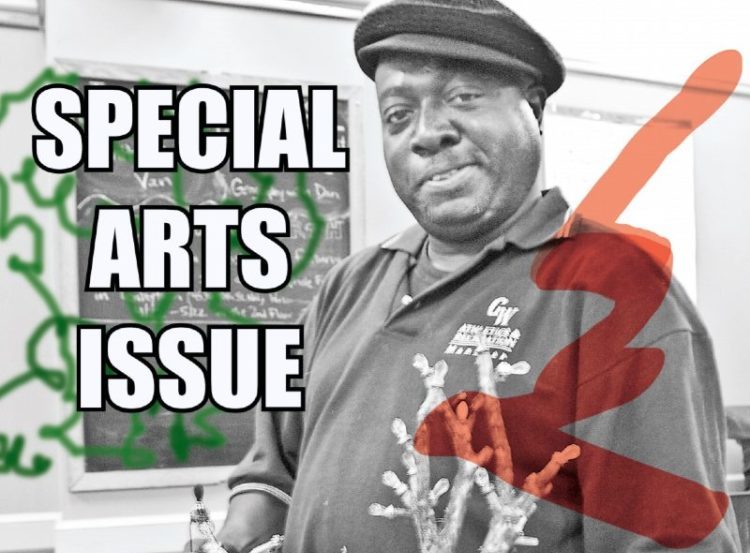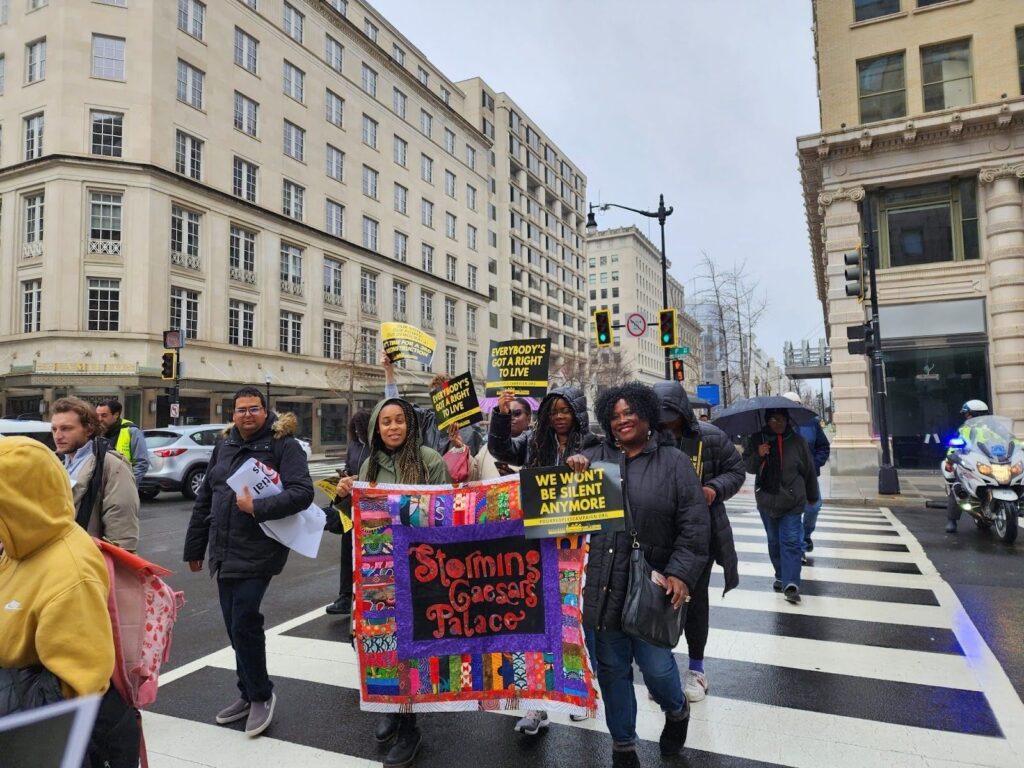Every weekday at 8 a.m., the staff and volunteers of Miriam’s Kitchen clear away the breakfast dishes and cover the tables with paint-spattered cloths. Then the art cart comes out. The paints and beads and balls of yarn beckon in a rainbow of colors.
A couple dozen men and women gather to choose their supplies, then settle back down around the tables. And the tenor of morning in the basement of Western Presbyterian Church in Foggy Bottom shifts. The businesslike clatter of a morning meal for 200 people in various stages of homelessness moves down to a quiet hum.
And the mysteries begin to unfold.
From the pencil of Thomas Spriggs, a four-headed dragon emerges. Under the hands of Richard Allen, a lion is growing from a lump of clay.
This is the first time Ronald Mackie has stayed after breakfast. He is surprised by the scene that flows from his colored pens – a turquoise house, a man and woman moving toward one another with open arms.
“Something got into me,” he says, wondering at the world on his paper.

“I’m really happy about it.”
Art therapy intern Kate Baasch watches the artists work. She sees homelessness as a challenge to a person’s sense of self. And she believes in the power of art to heal. Through their creations, she sees these artists exploring their pasts and reimagining their futures.
The District has over 6,000 homeless men women and children, and the majority of the folks who come to Miriam’s spend their nights in emergency shelters or streets and parks. A smaller percentage lives in transitional or permanent housing.
Some are coping with mental illness. Many have experienced trauma that is hard to put into words.
But words are not necessary for the art that is created here.
“It’s really a contemplative process,” says Baasch. The after-breakfast art studio “gives people a chance to sit and think, process things in a nonverbal way.”
Some people just linger and watch. They are also welcome, are also considered artists.
“I have a pretty broad definition of art,” says Baasch. “We say appreciation is a form of art.”
Whatever choice is made, that choice is empowering.
“I try to be creative, reframe things. Some people sleep in our group. We reframe it as ‘they are being our still-life models.’”
After all, the art room offers a rare quiet haven from the streets.

“There are not many places that homeless individuals can spend their days,” says Miriam’s case manager Amanda Moss. “I have personally seen how the opportunity to create art … has alleviated the stress of some of our guests. The availability of multi-media art supplies has allowed our guests to channel their negative energy into something beautiful, creative and positive.”
From out of their imaginations they draw powerful figures and inner stillness. One man at a table carefully paints the shadows on a tree branch that stretches across an otherwise blank sheet of paper. Another paints on canvas: a boardwalk, a beach with tiny frilled umbrellas. Patricia Alethia Queen paints apartment buildings.
“I make just the second floor.”
Divya Prabhakaran paints jewel-like landscapes, places of joy and serenity.
“It just relaxes my mind,” he says with a smile.
The act of creation, Baasch says, “invites a guest to the sanctuary of self.”
At one table, volunteer Liz Potamites teaches John Peterbark how to knit. Peterbark patiently winds and tucks the yarn as his eyeglasses, which have no sidepieces, slide slowly down his nose.
“I have a few situations but to heck with them,” he exults. “This is totally stress-relieving. I want to learn to crochet after this.”
A big man who identifies himself as the Great LA DALE shows off a sculpture, a fantastic landscape mounted on a platform of popsicle sticks: a tangled wilderness of jeweled trees, rocks, even two miniature tigers, leaping.
At the center of the scene is a lost child’s shoe.
The Great LA DALE says he found the small shoe in Southeast, lying on the street. The rest of the piece grew up around it. He says he never did art before he came to Miriam’s. Now his art, full of secrets and power, is lighting the way for him.
“My art tells me where to go with it.”
Miriam’s Kitchen was founded in 1983 by a collaboration of The George Washington University Hillel Student Association, Western Presbyterian Church and United Church in response to an urgent need for services for the homeless in downtown Washington, DC. The organization’s mission is to provide individualized services that address the causes and consequences of homelessness in an atmosphere of dignity and respect, both directly and through facilitating connections in Washington, DC.








